Touristic Information
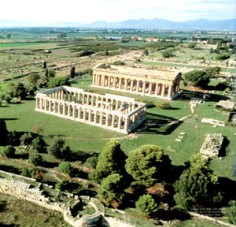
Paestum
If you want to spend a holiday made of fun and culture, Paestum is the perfect place. The beach is long (15 km) and wide and the sea of Cilento is beautiful. There is a wide pinewood between the beach and temple the road. Pines offer the possibility to enjoy cool moments in the hottest hours of the day. This is the perfect place to have a cool break during a long day spent on the beach. Inside the pinewood there are well-equipped camps that give the possibility to live in a pleasant nature with great comfort. Near the pinewood and the beach there are several hotels, too. Not far from the beach, there are the famous temples of Paestum, they are very well kept and they let the visitor live the magic ancient atmosphere of a world that was so important for our modern civilization. Visiting these temples, tourists live the charm of an ancient world and of magic rites of the past. The biggest and the most ancient temple is the one dedicated to Hera. This temple was called basilica. Another temple is dedicated to Poseidon and the third to Athena, the ancient goddess of wisdom.
Paestum is a city of ancient foundation. It was born with the name of Poseidonia in the 6th century BC, built by the Achaeans, Greek colonists from Sibari who chose it as a maritime commercial centers. Tourist resort, Paestum is nowadays at the same time one of the most important archeological centre in Italy and a well-known seaside resort, with its large beach, lined with pine wood and rich of hotels and outdoor facilities. Entering the ancient city is like engaging in an extraordinary journey through time, for the indescribable charm possessed by the well kept monumental structures. The wall around the ancient town is one of the most important examples of town fortification from the Western Greek period. The group of temples, all close to each other, is also very impressive. The largest one is Poseidon's, built in 450 BC, considered by scholars the greatest example of Doric temple architecture, with its magnificent triangular frontons and the remains of two altars used for the sacrifices to goddess Hera Argiva.
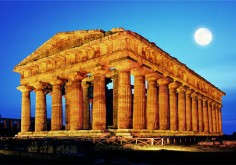
The most ancient temple is the so-called Basilica, of the 6th century BC, dedicated to Hera, of which 50 original Doric columns remain intact, the sacred well and the sacrificial altar. Then there is Cerere's temple, dedicated to Athena, with 34 fluted columns. The area is crossed by the Holy Road, along which many important civil and religiuous settlements have been found.You also ought to visit the National Archaeological Museum, where there are sculptures, bas-reliefs and tools from the excavation. Here you can also see the famous “Tuffatore”, recovered from a Greek tomb.
The Cilento National Park
Cilento e Vallo di Diano National Park is the second largest park in Italy. It stretches from the Tyrrhenian coast to the foot of the Apennines in Campania and Basilicata, and it includes the peaks of the Alburni Mountains, Cervati and Gelbison and the coastal buttresses of Mt. Bulgheria and Mt. Stella.The extraordinary naturalistic richness of the heterogeneous territory goes hand in hand with the mythical and mysterious character of a land rich in history and culture: from the call of the nymph Leucosia to the beaches where Palinuro left Aeneas, from the ruins of the Greek colonies of Elea and Paestum to the wonderful Certosa of Padula. And everything else you can find in such an unexplored territory.
More Info: http://www.parks.it/parco.nazionale.cilento/Eindex.php
The Coast
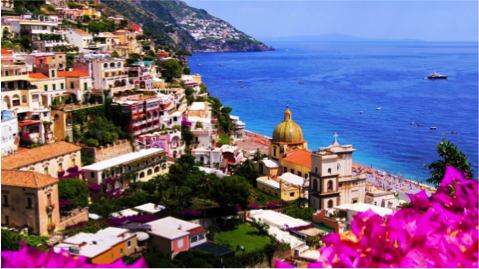
Amalfi is a town in the province of Salerno that lies at the mouth of a deep ravine, at the foot of Monte Cerreto, surrounded by dramatic cliffs and coastal scenery. The town of Amalfi was the capital of the maritime republic known as the Duchy of Amalfi, an important trading power in the Mediterranean between 839 and around 1200. It occupied a high position in medieval architecture; its cathedral of Sant'Andrea (Saint Andrew, 11th century), the campanile, the convent of Cappuccini, founded by the Amalfitan Cardinal Pietro Capuano, richly represent the artistic movement prevailing in Southern Italy at the time of the Normans, with its tendency to blend the Byzantine style with the forms and sharp lines of the northern architecture.
Ravello
One of the gems of the Amalfi coast is Ravello, 350 meters above
sea level, where the light effects and magical architecture create
a vision of rare intensity. Its name is immortalized in
Boccaccio’s Decameron. Famous for its tranquil and serene
atmosphere, Ravello offers architectural gems of rare elegance.
The 11th century Duomo, dedicated to San Pantaleone, is rich with
artistic treasures like the grand bronze central door adorned with
54 panels. To the right of the Cathedral a square tower marks the
entrance to Villa Rufolo. Immersed in a verdant park of exotic and
mediterranean flora, the original structure dates back to the 13th
century and even today some of its arab-siculian architecture is
evident.
Villa Cimbrone was, originally, a simple hut. It was bought in
1904 by Ernest William Beckett, who transformed into an
exceptionally fascinating Villa. It has hosted many celebrated
personalities, from Winston Churchill to Greta Garbo. The
belvedere is a terrace that gives on to infinity, and has no equal
in the world.
Positano was a port of the Amalfi Republic in medieval times, and prospered during the sixteenth and seventeenth centuries. By the mid-nineteenth century, however, the town had fallen on hard times. More than half the population emigrated, mostly to America. It was a relatively poor fishing village during the first half of the twentieth century. It began to attract large numbers of tourists in the 1950s, especially after John Steinbeck published his essay about Positano in Harper's Bazaar in May, 1953. The church of Santa Maria Assunta features a dome made of majolica tiles as well as a thirteenth-century Byzantine icon of a black Madonna.
Vietri sul Mare (“on the Sea”) is a village near Salerno. It is a popular tourist destination and it is a convenient place to visit the Amalfi Coast. The inhabitants call it “The First Pearl of the Coast,” claiming that the Amalfi coast begins there. Vietri is popular also for the production of ceramics (dishes, flowerpots, vases and tiles) that can be found in restaurants, hotels and homes throughout the Amalfi area.
By boat: www.gruppobattellieriamalfi.com
By bus: http://www.sitabus.it/salerno-costiera-amalfitana-orari-autobus/
Salerno
Placed in the heart of the homonymous gulf, Salerno represents the combination between a fascinating history and a huge sphere of artistic, urbanistic and architectural beauties.
Brief History
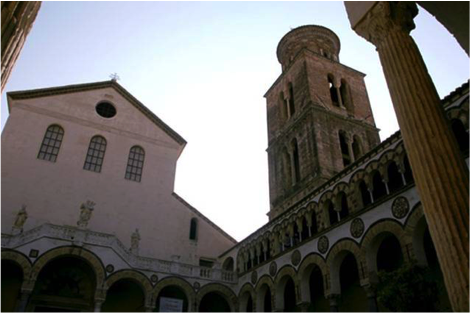 The area of Salerno
hosted a small Pre-Roman settlement, as witnessed by the Etruscan necropolis in the quarter of
Fratte. The Roman castrum Salerni was then founded in 197 BC. In
the middle ages Salerno became the main Longobard principality in the south of
Italy. In this period the Schola Medica Salernitana, the oldest
university in Europe, became the center of the whole European
medical knowledge in the middle ages. With the arrival of the Normans
lead by Robert
Guiscard, Salerno was still the major center of the southern Italy, even
offering protection to the Pope for a few years. However, the
capital of the Norman reign uniting the whole southern Italy was
later moved to Palermo, and with the emperor Frederick II, Salerno definitely lost its
capital role in favour of Naples.
The area of Salerno
hosted a small Pre-Roman settlement, as witnessed by the Etruscan necropolis in the quarter of
Fratte. The Roman castrum Salerni was then founded in 197 BC. In
the middle ages Salerno became the main Longobard principality in the south of
Italy. In this period the Schola Medica Salernitana, the oldest
university in Europe, became the center of the whole European
medical knowledge in the middle ages. With the arrival of the Normans
lead by Robert
Guiscard, Salerno was still the major center of the southern Italy, even
offering protection to the Pope for a few years. However, the
capital of the Norman reign uniting the whole southern Italy was
later moved to Palermo, and with the emperor Frederick II, Salerno definitely lost its
capital role in favour of Naples.
In September 1943, during the World War II, Salerno was the scene of the Operation Avalanche and suffered a great deal of damage. From February 12 to July 17, 1944, it hosted the Government of Marshal Pietro Badoglio. In those months Salerno was the temporary "Capital of the Kingdom of Italy", and the King Victor Emmanuel III lived in a mansion in its outskirts.
Salerno today
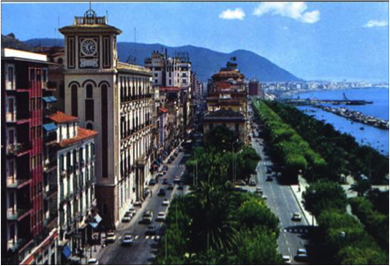 Salerno is a very lively town that has been rapidly renewing its
look in the last few years. From west to east, we find the
commercial port, the old town, and the modern center ending at the
train station. Beyond the station, the town has considerably grown
in size in the last fifty years, reaching 140,000 inhabitants. You
will certainly appreciate the shops of Via dei Mercanti in the old
town and Corso Vittorio Emanuele in the modern center, stretching
eastward to the train station. With fine weather, have a stroll on
the beautiful Lungomare (seafront). You will find a lot of
restaurants and pubs both in the old town and in the modern
center. In particular, people use to cluster in Via Roma in front
of the town hall.
Salerno is a very lively town that has been rapidly renewing its
look in the last few years. From west to east, we find the
commercial port, the old town, and the modern center ending at the
train station. Beyond the station, the town has considerably grown
in size in the last fifty years, reaching 140,000 inhabitants. You
will certainly appreciate the shops of Via dei Mercanti in the old
town and Corso Vittorio Emanuele in the modern center, stretching
eastward to the train station. With fine weather, have a stroll on
the beautiful Lungomare (seafront). You will find a lot of
restaurants and pubs both in the old town and in the modern
center. In particular, people use to cluster in Via Roma in front
of the town hall.
Places of interest in Salerno
The Medieval Castle “Arechi Castle”
The Cathedral of San Matteo and San Gregorio Magno
The Church of San Giorgio
The Church of San Benedetto
The Gardens of Minerva
The Diocesan Museum of San Matteo
Pompei
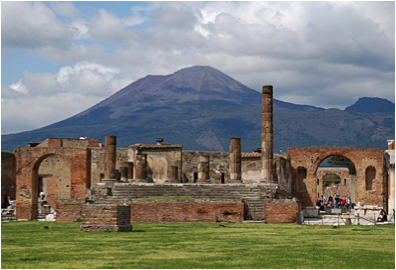
The city of Pompeii was an ancient Roman town-city. Pompeii, along with Herculaneum, was mostly destroyed and buried under 4 to 6 m (13 to 20 ft) of ash and pumice in the eruption of Mount Vesuvius in 79 AD.
The eruption destroyed the city, killing its inhabitants and burying it under tons of ash. Evidence for the destruction originally came from a surviving letter by Pliny the Younger, who saw the eruption from a distance and described the death of his uncle Pliny the Elder, an admiral of the Roman fleet, who tried to rescue citizens. The site was lost for about 1,500 years until its initial rediscovery in 1599 and broader rediscovery almost 150 years later by Spanish engineer Rocque Joaquin de Alcubierre in 1748. The objects that lay beneath the city have been well-preserved for centuries because of the lack of air and moisture. These artefacts provide an extraordinarily detailed insight into the life of a city during the Pax Romana. During the excavation, plaster was used to fill in the voids in the ash layers that once held human bodies. This allowed one to see the exact position the person was in when he or she died.
By bus:
Herculaneum
Herculaneum was an ancient Roman town destroyed by volcanic pyroclastic flows in 79 AD. It is also famous as one of the few ancient cities that can now be seen in almost its original splendor; unlike Pompeii, it was mainly affected by pyroclastic flows, thus preserving the wooden objects such as roof tops, building beams, beds, doors, and even food. Moreover, Herculaneum was a wealthier town than Pompeii, possessing an extraordinary density of fine houses, and far more lavish use of colored marble cladding. The discovery in recent years of about 300 skeletons along the seashore came as a surprise, as it had been assumed that the town had been evacuated.
From Pompeii: Circumvesuviana http://www.eavsrl.it/web/it
Natural parks
 Salerno is surrounded by two national parks: Vesuvio and
Cilento; and two regional parks: Monti Lattari, Monti Picentini.
The highest mountains, touching 1800 m, are covered by a dense
forest very rich in waters. They offer beautiful views on
Salerno gulf and the whole Campania region. Among the hundreds
of trails in the region, the most famous is Sentiero degli Dei
("Path of the Gods"), on the top of Amalfi coast. The dominant
rock is limestone, which is ideal for climbing, especially in
the Amalfi coast, where many climbing sites are equipped.
Salerno is surrounded by two national parks: Vesuvio and
Cilento; and two regional parks: Monti Lattari, Monti Picentini.
The highest mountains, touching 1800 m, are covered by a dense
forest very rich in waters. They offer beautiful views on
Salerno gulf and the whole Campania region. Among the hundreds
of trails in the region, the most famous is Sentiero degli Dei
("Path of the Gods"), on the top of Amalfi coast. The dominant
rock is limestone, which is ideal for climbing, especially in
the Amalfi coast, where many climbing sites are equipped.